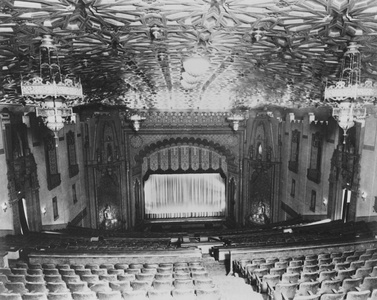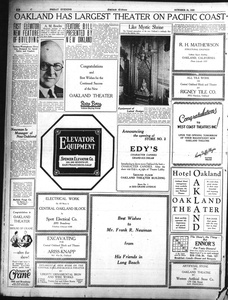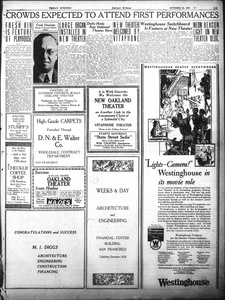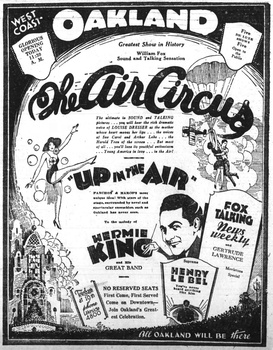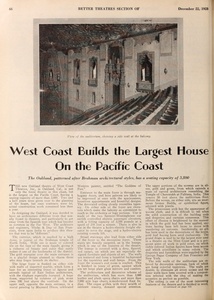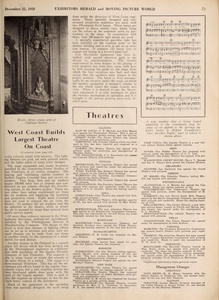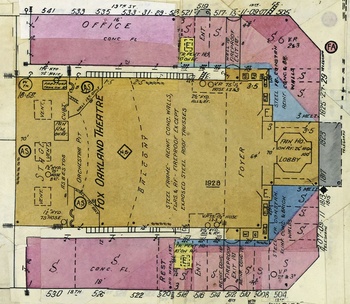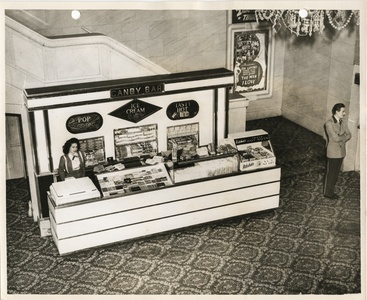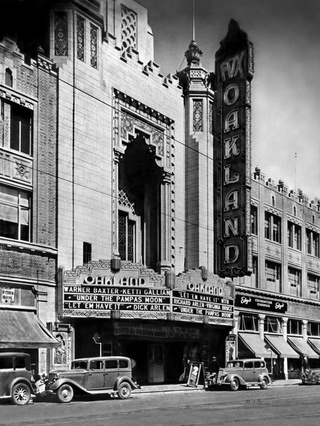 c.1935. image needs source
c.1935. image needs source
The Fox Oakland Theater is a historic theater in the Uptown neighborhood. Built in 1928 as the Oakland Theater for West Coast Theaters, the fanciful “Brahmanian Temple” movie palace had a seating capacity of 3,335* and was the largest theater on the West Coast when constructed. It was designed by the San Francisco architecture firm of Weeks and Day, and the surrounding office and retail space was designed by Oakland architect Maury I. Diggs who was also the developer. A Wurlitzer organ and an orchestra provided live music as part of feature programs. The sign was by the Electrical Products Corporation. 1
*NB: Jack Tillmany's Theatres of Oakland says the capacity was 3,335. 1928 articles say 3,800.
The organ console was on a lift that could also rotate it 180' so the organist could face the audience. The theater was built with a stage for live performances, but was one of the first major theaters designed with showing "talkies" in mind rather than retrofit later. The sound system for movies was also on a lift; it could be raised into position behind the movie screen. 4
The building also originally included a neon light at the top:
A specially constructed gas-tube light has been installed on the topmost point of the theatre building and is now in use as an aviation beacon. It contains 125 linear feet of orange red tubing in a beveled ball. 4
1928 Opening
More than 20,000 people turned out for the grand opening in October 1928 after the the theater management bought the inbound trains of the entire Key System line for an hour which allowed movie customers to ride for free.
For the 1928 opening they had a 3 page spread in the Tribune. 1
The opening bill included talking film The Air Circus (1928); a dance and music production, "Up in the Air" by Fanchon and Marco; Hermie King and his 20-piece orchestra; and newsreels. 1
Design
The style has been called a hybrid of Indian, Moorish, and Medieval elements, but a 1928 Exhibitors Herald and Moving Picture World article specifically mentions India and Brahman-style temples, and the Temple Chawmukh at Palitana, India. (Although the article incorrectly identifies the figures in front of the organ grilles as statues of Buddha.) 4 The steep dome is similar to a shikhara ("mountain peak") on historic Hindu and Jain temples of northern India, and various other features have similarities. Architectural historian Scooter Marriner has theorized that Weeks and Day were likely to have a copy of Fletcher Barister's A History of Architecture on the Comparative Method (published 1895 and republished 1905) which includes a picture of the shikhara of the Chawmukh temple, which has a very similar shape. The large window above the marquee has a similar shape to the main entrance to the temple as well.
The elevator button for the mezzanine is marked with a 'V' rather than a 'M' as might be expected. It's theorized that the 'V' is for vihāra or monastery. The meaning of the word has evolved over the years, but a later meaning was "a hall that was used as a temple or where monks met and some walked about" which is a lot like a mezzanine of a theater.
There was a mural by Maynard Dixon on the upper wall opposite the main entrance of a figure seated on a lotus flower and surrounded by processions of figures (some on foot, some on horseback, and some riding elephants.) Dixon called it "Indian Goddess," but at some point someone took the lotus flower to be flames and dubbed it "Goddess of Fire." (There was a face in the clouds, wreathed by flames.) The figure is likely based on Tara, a Buddhist deity, who comes in different forms and colors.
Supposedly the theater was originally going to be called The Bagdad Theater, but the name was changed to the West Coast Oakland Theater at the request of mayor John L. Davie. 2
The marquee was remodeled in 1935; the original was rectangular. The photo below from the Oakland History Center is dated 1941, but it's likely from 1929, as that's when the version of Romance of the Rio Grande starring Warner Baxter was released. Fanchon and Marco's "Jazz Temple Idea" was created in 1928.
 ohrphoto.oaktheaters.017, original marquee
ohrphoto.oaktheaters.017, original marquee
1946 Remodel
The theater was remodeled in the 1946. The remodel included the stainless steel facade and mosaic floor at the entrance. It also connected the office wings, and one of the elevators was switched to provide service for the offices instead of the theater.
The Maynard Dixon mural was sealed behind a wall at this time. Supposedly it disappeared in 1984 or 1985 under mysterious circumstances.
The renovation follows the 1946 version of the theater, not the original 1928 design.
2009 Reopening
The theater closed as a Fox theater in 1966 as Oakland was losing its theaters and shopping. After closing completely in 1973, the theater reopened in 2009 following extensive renovations.
On March 28, 1978, the Fox Oakland Theater and Building (1807 - 1829 Telegraph Avenue) were designated Oakland Landmark #23, under Zoning Case #LM 78-36, and is also listed on the National Register of Historic Places.
The Fox Theater was the recipient of the East Bay Express Music Venue Readers' Poll Award in 2014 and 2015.
Location
1807 Telegraph Avenue, Oakland
Telephone
510.302.2250
Modern Photos
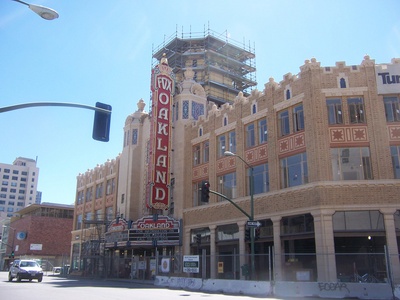 photo CC BY-NC-SA 2.0 by www78
photo CC BY-NC-SA 2.0 by www78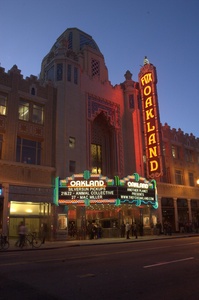 CC SA-BY Our Oakland
CC SA-BY Our Oakland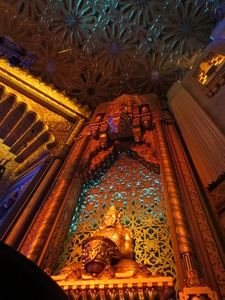 CC SA-BY Our Oakland
CC SA-BY Our Oakland
Links and References
- The Fox Oakland official website
- Promotional video about the history of the theater created by the Oakland Redevelopment Agency
- New Oakland Theater Opens At Noon Tomorrow Oakland Tribune October 26, 1928 (p2, p3)
- The Forum (letters to the editor) Oakland Tribune November 16, 1927
- ohrphoto.oaktheaters.020 Oakland History Center, Oakland Public Library
- West Coast Builds the Largest House on the Pacific Coast Exhibitors Herald and Moving Picture World December 22, 1928


